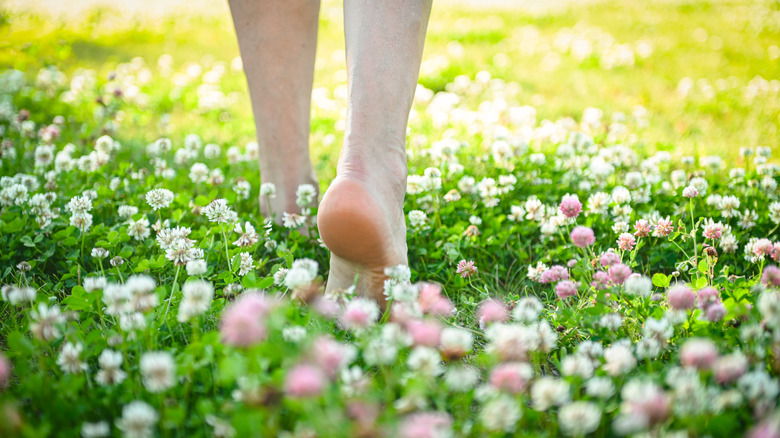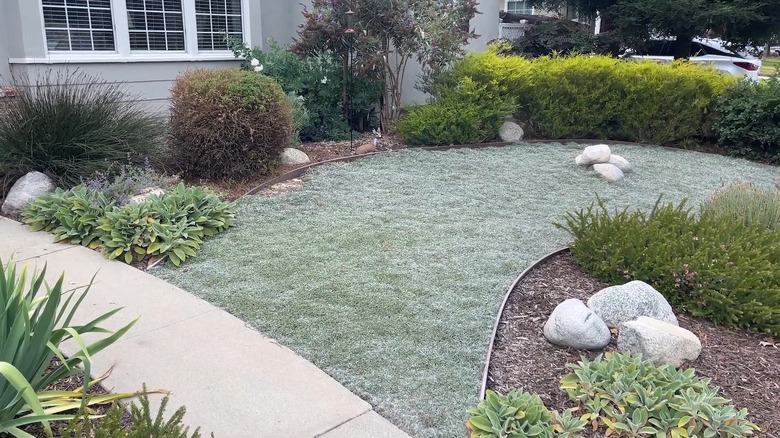Get A Healthy Lawn With 6 Grass Alternatives That Can Take The Heat
When people imagine a beautiful yard, a lawn full of healthy grass is probably one of the first things that comes to mind. However, despite its popularity, grass isn't the only option. Grass can require a lot of maintenance and high amounts of water. If you live in an area that regularly experiences high temperatures, continuous irrigation might be needed to keep your grass green. Cool-season grasses tend to turn brown in high temperatures, even with watering, leaving your lawn looking sad and crispy. Warm-season grasses are better suited to searing summers, but unless you keep them very well-watered, they too can turn brown during heat-triggered dormancy.
Looking to have a healthy "lawn" even in the height of a scorching summer? You'll be happy to hear that there are various groundcovers which can replace grass, and are eco-friendly, easy to maintain, and ideal for USDA growing zones in warm climates. With these heat-tolerant options, you can have a lawn that will stand up to high summer temps and remain healthy with less water.
Before we dive into these 6 grass alternatives that can take the heat, there's one important caveat to mention: while lawn alternatives have many benefits, these groundcovers aren't as resilient to traffic as regular turfgrass. Areas that receive unrelenting traffic may need some stepping stones, spaced out pavers, or a solid paved pathway installed. You'll also want to be strategic about where you use grass alternatives in your outdoor space. Front yards with a paved pathway to the front door, or backyards that see gentle use, can be a perfect place to try out a lawn look-alike groundcover. But in a confined area where kids and large dogs love tearing around, turfgrass alternatives might take a bit of a beating. Now that you're aware of the main limitation of groundcovers as a lawn replacement, and how to address it, discover which are the most resilient to heat.
Kurapia can take a lot of heat without requiring constant watering
Kurapia is a beautiful green groundcover plant with a carpet-like appearance that features tiny flowers. It's been making waves as a grass alternative because it loves hot temperatures, and doesn't require a lot of water or mowing. Because it's so drought-tolerant, a Kurapia lawn can even qualify homeowners for turf rebate programs in certain counties. This tough grass alternative thrives in areas where the average daily temperature is at least 45 degrees Fahrenheit, doing well in arid areas like Arizona and Nevada. It is only hardy to USDA Zone 7b and doesn't do well in colder climates (places that are consistently below 38 degrees Fahrenheit) and will go dormant in frosty weather/freezing temperatures. However, if your Kurapia is well-rooted, it can come back once the weather warms up.
Since Kurapia is a sterile plant, you'll need to buy plugs in order to grow it. Experts suggest planting your plugs in holes that are about 2 inches wide and 3 inches deep. In the first week after planting, you'll want to water your Kurapia around 3-7 times a week. However, once the plant reaches maturity, you can taper watering back to once a week or twice a month. Ideally, mow once a month to keep your Kurapia lawn neat and encourage lateral growth.
Consider creeping thyme for areas that don't see a ton of traffic
Your spice rack isn't the only place where thyme could be a game-changer. Planting creeping thyme as a ground cover can be the perfect way to get a heat-resistant lawn that will also turn heads. Creeping thyme is a beautiful plant that boasts tiny green leaves and small pink/purple flowers. Unlike grass, creeping thyme doesn't require much water, and it doesn't have to be mowed. This plant thrives in USDA Hardiness Zones 4-9 and can tolerate direct sunlight and heat. It grows best when temperatures are between 65 and 85 degrees Fahrenheit. While the plant can survive in much higher temperatures, growth will slow in extreme heat. Likewise, temperatures below 0 degrees Fahrenheit will result in dormancy.
Creeping thyme generally doesn't need fertilizer and can tolerate poor soil. However, it does best with lots of drainage, won't do well in very wet, compacted soils, and prefers a neutral or mildly alkaline pH. Once the plant reaches maturity, it will only need to be watered if there are long periods without rain. Something to keep in mind before investing in creeping thyme is that it works best in areas that get light to moderate foot traffic. Placng stepping stones along the areas you frequently walk can help prevent bare patches from developing.
Dymondia is another drought-resistant alternative that never needs to get mowed
Sometimes referred to as silver carpet, Dymondia is a slow-growing groundcover plant that's native to South Africa. It thrives in USDA Hardiness Zones 9-11 and heat zones 8-12 which means that it can withstand high temperatures. On the other hand, Dymondia will die if temperatures drop below 28 degrees Fahrenheit. It can tolerate moderate foot traffic, never needs mowing, and suppresses weeds — making it a nice option for those looking for a non-grass lawn covering in hot, dry areas. Dymondia sprouts adorable little yellow flowers that can attract bees, which can be great for people wanting to bring more pollinators to their yard.
Despite being resistant to heat, Dymondia does require weekly watering and may need more water during the summer months. Before you decide to grow silver carpet as a grass alternative, it's important to note that Dymondia does best in full sun. If your yard is very shady, this plant might not be the best fit. Another downside to Dymondia is that it attracts gophers. These animals love to eat the plant, which could hurt your lawn's appearance.
Clover lawns can look good year-round in warm climates
Since clover is technically a weed, it probably doesn't come to everyone's minds when they think of lawn coverings. But clover has been enjoying some popularity recently as a more water-wise, low-maintenance, and pollinator-friendly grass alternative. Clover can tolerate more heat than grass and is best suited for USDA Hardiness Zones 3-10 (depending on the type) but it can also do well in shady areas, and can maintain its green appearance all year long in warm climates that don't see frost. Clover lawns also don't require much maintenance, as they only need to be mowed occasionally. In general, clover lawns only need to be trimmed a few times a year, and some people may prefer to maintain a longer look. A clover lawn can also help you cut down on water usage after establishment.
When planting clover, you should be mindful of the fact that it doesn't need much fertilizer. This plant is known for fixing nitrogen from the air, and can survive in many soil types. However, the most ideal soils are loamy and sandy. Before making the decision to plant a clover lawn, keep in mind that clover comes in around 300 different species, some of which are considered invasive in certain parts of the United States. For example, both red and white clover should not be planted in Oregon, Wisconsin, Kentucky, and Virginia. It's always a good idea to research the species you're interested in to determine if it's invasive in your area.
You'll also need to decide which type of clover is best for your yard. For example there are pros and cons to choosing a micro clover lawn versus white clover lawn – white clover is cheaper to buy as seed and fills in faster, but is also quicker to spread into flower beds. To help you pick the right one, here is a guide on what seeds to buy when starting a clover lawn for the best results.
Dwarf carpet of stars thrives in warm weather and never needs mowing
Dwarf carpet of stars (aka Ruschia 'Nana') is another hardy ground cover that doubles as a stunning grass lawn alternative. Like Dymondia, this low-growing succulent groundcover hails from southern Africa, and is adapted to thrive in harsh, dry conditions. Besides being drought tolerant, Dwarf carpet of stars is also able to happily handle a lot of heat, taking temperatures ranging from 20 degrees all the way up to 120 degrees Fahrenheit. Once filled in, the plant creates a dense, tight mat that never needs to be mowed, can handle a certain amount of foot traffic, and will stay green year-round. As a bonus, the plants will put out small, light pink flowers in spring and fall.
To establish a patch of dwarf carpet of stars, you'll need to clear the area of grass and weeds. While Ruschia 'Nana' will grow in a range of soils, adding some organic matter to improve the structure of very sandy or heavy soil can help speed its establishment. The quickest way to fill up an area is by buying plugs and spacing them out every few inches. Once planted, you will need to water the plugs lightly every day for a few weeks, then switch to deeper waterings. Established areas will only need water every 7-10 days during the growing season (max), and less in the fall and winter or if there has been rain.
Yarrow has a leafy green look and can be mowed into a low mat
From a distance, yarrow lawns may have a similar appearance to traditional turfgrass, but up close, yarrow is full of surprises. This beautiful plant has a leafy look and can develop into a dense mat if mowed. Suited for USDA Hardiness Zones 3-9, yarrow thrives in warm temperatures, tolerates heat, and doesn't need much water once fully established. Unlike some of the other plants on the list, yarrow can also survive cold weather, although it will die back when temperatures drop. In order to keep the plant healthy, it's important to ensure it doesn't get waterlogged during the winter.
Besides being resilient to heat and drought, yarrow has another appealing quality: it's one of those beautiful plants that don't have a problem with poor soil. It doesn't need fertilizing and will adapt to arid ground. Yarrow's ability to survive in a variety of conditions is one of its best qualities, but it also means that yarrow can become weedy, so you'll need to be mindful of making sure that it doesn't spread to unwanted areas of your yard. To plant, you can either sow stratified seeds in spring, or divide an established plant and bury the small rhizomes. Because it sometimes occurs as a turfgrass weed, you might even find you already have some growing in your lawn. When left unmowed, yarrow can eventually sprout small white, yellow, red, or pink flowers — but these flowers come atop tall woody stems. If you want to maintain a dense, low "lawn" that's pleasant to walk on, it's advisable to mow the area before these stems mature. If you let the stems grow tall and then mow them down, you might be left with hard, spiky stubs that aren't pleasant to step on. Like most lawn alternatives, although yarrow can handle foot traffic, it's not as durable as grass, so don't plant it in a super high-traffic area, or make provision to alleviate the impact through stepping stones or spaced-out pavers.

